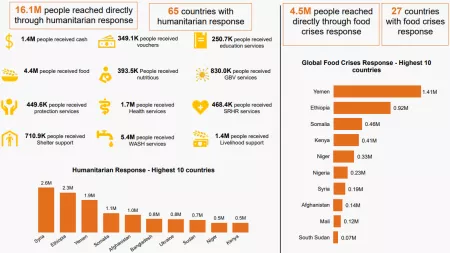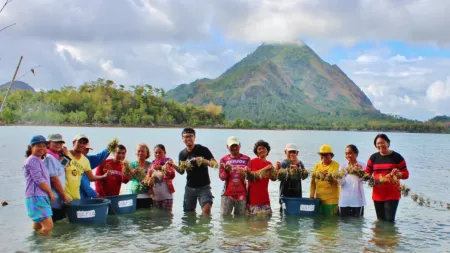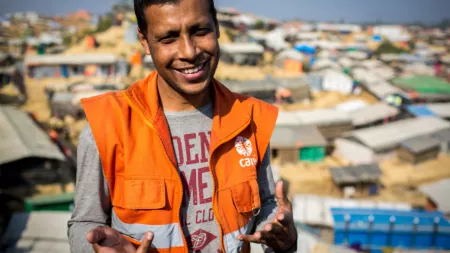The world of humanitarian response is bigger and more diverse than most people imagine. It spans from trucking in water, getting people cash to get back on their feet, and helping people start businesses to build their futures out of a crisis. CARE and partners do it all, working with people impacted by crises and local organizations to figure out the best steps to help people cope with the emergencies they face.
According to CARE Caucasus, the biggest achievement of the Ukraine Response team recently has been the successful selection of 11 women-led community initiatives to receive grants to start emergency responses themselves. Besides the fact that these initiatives are determined to support the integration of Ukrainian refugees, they are implemented by Ukrainian women. The co-director of newly registered organization Creative Studio Orange, Iryna Haitota, a refugee woman from Zaporizhizhia, Ukraine shared: "I joined this initiative to support my teenage daughter who was willing to share her creativity by supporting younger fellow Ukrainian children. Nevertheless, taking the responsibility to run an organization, having the opportunity to attend additional language courses and meet people from the community sphere, gave me the empowerment which I never had in Ukraine, as a housewife.”
Since July 1, 2022, CARE and our partners have reached 16.1 million people with emergency response in 65 countries. In the biggest 5 responses alone—Syria, Ethiopia, Yemen, Ukraine (including work in Poland, Romania, Slovakia, Germany, and Moldova), and Somalia—we’ve reached 9.1 million people. That’s 10.7% of the people who need humanitarian response in those crises.

What has changed?
- 5.4 million people have gotten water or hygiene services. In Iraq, for example, the team is training women who have fled their homes to provide plumbing services and improve water for the communities where they live now. In India, the team is training volunteers in Odisha state to chlorinate water and repair water systems.
- 4.4 million people have more food. That includes the 27 countries where CARE is doing food crisis response. In the Philippines, the team is partnering with Mindanao State University to support seaweed farmers in Tawi-Tawi, since seaweed is a key crop for food and for sale. In Sri Lanka, Chrysalis is providing school meals for students at the University of Colombo, since the students were dropping out of school because they could not eat.
- 1.7 million people got health services, including 468,000 people who got reproductive health care. In Vanuatu, the team partners with the Ministry of Health to improve vaccination rates in the provinces that have high vaccine hesitancy. They’re using data dashboards with the Ministry to help everyone make faster, more informed decisions.
- 1.4 million people got livelihood support. When Dalia—a Sudanese refugee supported by CARE’s projects—joined the 'Takafol' VSLA in Egypt, she took out her first loan to repair her broken tuktuk, which was her main source of income. She used that income provide for her son, pay her rent, and take care of her physical health. With her second loan, she started a small business by selling Sudanese handmade products to her local community. Now, she has doubled her monthly income.
- 1.4 million people have gotten cash and 349,000 people have gotten vouchers. In Honduras, women and girls asked for cash transfers as the most effective way to get support, so that’s what CARE and our partners did. In Ethiopia, people are using cash and vouchers to rebuild their farms and businesses after years of crisis.
- 830,000 people got GBV services, and 450,000 got protection services. In Colombia, the team is scaling up its GBV response model nationwide in collaboration with OIM. In Moldova, the team is providing safeguarding training for local partners, since local partners identified that as a key need. In South Sudan, 39,690 people got emergency GBV support.
- 711,000 people got access to shelter. Shelter ranges from tents to host communities to cash so people can pay rent, depending on the context of the crisis.

How did we get there?
- Focus on gender equality. 55 countries are using the gender marker on all of their humanitarian proposals to ensure that we’re addressing inequality. 40 countries (60%) are doing Rapid Gender Analyses to ensure they can build more gender equal responses.
- Get women involved in decisions. 38 countries (58%) have at least some projects that are focusing on women’s decision making in emergencies and promoting women’s leadership. 25 countries are using the Women Lead in Emergencies approach. For example, in Zimbabwe, women in savings groups are mobilizing to demand more space for women’s leadership in crisis situations.
- Be accountable. 50 countries (76%) have standard feedback and accountability mechanisms for all of their programming, and 12 have for at least some of their programs. 52 countries have included participants in designing and creating their feedback channels.
- Get involved in coordination and leadership. 56 countries are involved in the UN Cluster system to help better coordinate responses to crises. 36 countries are involved in the humanitarian country teams. In Malawi, the government has recognized CARE’s contributions responding to Cyclone Freddy. The team in Ecuador is leading inter-agency coordination locally and nationally. In Mozambique, the team is contributing to UN OCHA’s sector evaluations, and CARE is recognized as a leader in emergency response.
In the current context of overlapping humanitarian crises across the globe, now more than ever we need responses that are coordinated, accountable, with gender equality at the heart. This is the only way to ensure that all most vulnerable people will get not only the specific and immediate help they need, but also the support to rebuild their lives in the long term.
